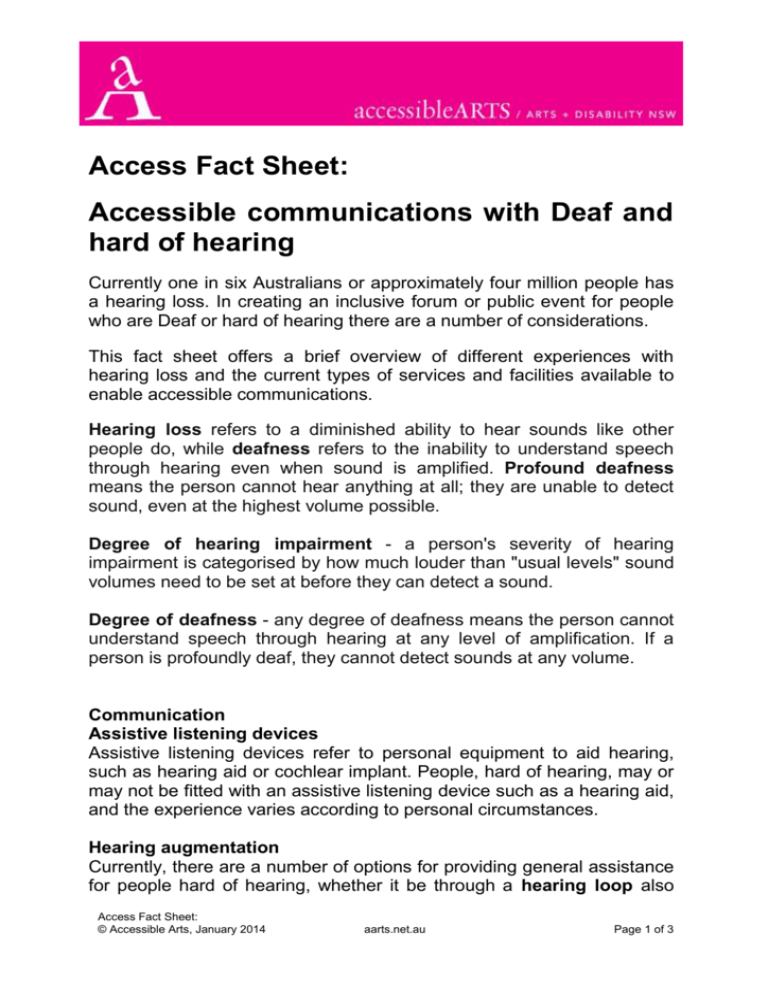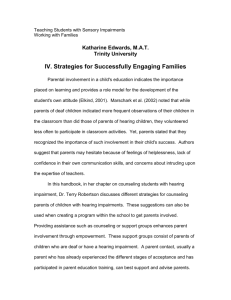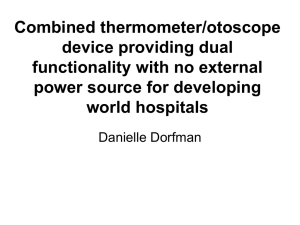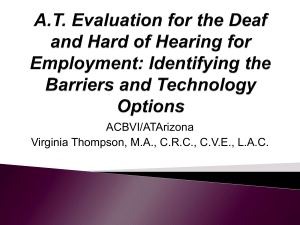Hearing loss - Accessible Arts
advertisement

Access Fact Sheet: Accessible communications with Deaf and hard of hearing Currently one in six Australians or approximately four million people has a hearing loss. In creating an inclusive forum or public event for people who are Deaf or hard of hearing there are a number of considerations. This fact sheet offers a brief overview of different experiences with hearing loss and the current types of services and facilities available to enable accessible communications. Hearing loss refers to a diminished ability to hear sounds like other people do, while deafness refers to the inability to understand speech through hearing even when sound is amplified. Profound deafness means the person cannot hear anything at all; they are unable to detect sound, even at the highest volume possible. Degree of hearing impairment - a person's severity of hearing impairment is categorised by how much louder than "usual levels" sound volumes need to be set at before they can detect a sound. Degree of deafness - any degree of deafness means the person cannot understand speech through hearing at any level of amplification. If a person is profoundly deaf, they cannot detect sounds at any volume. Communication Assistive listening devices Assistive listening devices refer to personal equipment to aid hearing, such as hearing aid or cochlear implant. People, hard of hearing, may or may not be fitted with an assistive listening device such as a hearing aid, and the experience varies according to personal circumstances. Hearing augmentation Currently, there are a number of options for providing general assistance for people hard of hearing, whether it be through a hearing loop also Access Fact Sheet: © Accessible Arts, January 2014 aarts.net.au Page 1 of 3 known as an induction loop, FM or Infrared transmission or a personal loop. These systems require amplification of the voice in order to be effective. Hearing loops can be created through the installation of a coil around the space where the augmentation is required, such as a meeting room or a theatre auditorium. Other ways to generate hearing augmentation is through either an infrared system or using an fm system to send audio signal to a receiver, such as a hearing aid or headsets, provided as part of the service. Each arrangement has relative merits depending on the venue, the period of use, and support staff. At a live event or forum, both the presenters and the people from the audience asking the question need to be amplified by speaking into a microphone in order for the assistive listening device to be effective. Captioning Captioning provides visual communication of spoken language and audio cues in the form of text. Captioning has a number of protocols to ensure clear communication, such as indicating who is speaking as well as relevant audio that may not be understood by just watching the action – such as a sound effect with no visual cues. Captioning is not a substitute for Auslan interpretation Auslan Auslan, Australian Sign Language, is the language of the Australian Deaf community. It is a gesture based language with it’s own grammar and vocabulary, and is not a direct translation of spoken or written English. It is recognised by the Australian Government as ‘a community language other than English’. Interpreters are often required to aid effective communication between a hearing person and someone who is Deaf. People who use Auslan as their first language require a NAATI accredited professional interpreter to translate spoken word into Auslan, and provide voice for the Deaf person. Resources and Links Access Fact Sheet: © Accessible Arts, January 2014 aarts.net.au Page 2 of 3 Printacall Communication Technologies – hearing augmentation systems http://www.printacall.com.au/ Auslan Services – Auslan interpreters http://www.auslanservices.com/ SLCommunications - Auslan interpreters http://nsw.slcommunications.com.au/ Auslan Stage Left – Auslan interpreters for theatre http://www.auslanstageleft.com.au/ The CaptioningStudio.com – captioning for theatre http://captioningstudio.com/live-captioning/ Ai Media http://ai-media.tv/ CSI captioning http://www.captioningandsubtitling.com.au/ Red Bee Media https://lrc.redbeemedia.com.au/ STENOcaptions Australia http://stenocaptionsaustralia.com/index.php?p=1_2_Products The Substation http://thesubstation.com.au/ Access Fact Sheet: © Accessible Arts, January 2014 aarts.net.au Page 3 of 3








